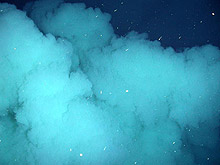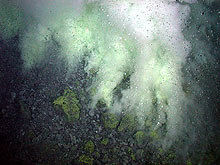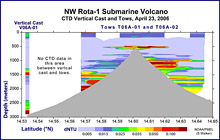On our first dive at NW Rota-1 volcano, a volcanic fog enveloped the entire volcano top, preventing us from finding Brimstone Pit. Click image for larger view and image credit.
This Place Is Amazing!
April 24, 2006
Bob Embley
Chief Scientist — Submarine Ring of Fire 2006
Geophysicist
NOAA Vents Program, Pacific Marine Environmental Laboratory
![]() Jason
II approaches Brimstone Pit.
(Quicktime, 2 Mb.)
Jason
II approaches Brimstone Pit.
(Quicktime, 2 Mb.)
![]() Jason
II returns to Brimstone Pit. (Quicktime, 1.9 Mb.)
Jason
II returns to Brimstone Pit. (Quicktime, 1.9 Mb.)
![]() Jason
II finds gas bubbles emitting from lava rock. (Quicktime, 1.8 Mb.)
Jason
II finds gas bubbles emitting from lava rock. (Quicktime, 1.8 Mb.)
![]() This
appears to be lava erupting from Brimstone Pit. (Quicktime,
1.8 Mb.)
This
appears to be lava erupting from Brimstone Pit. (Quicktime,
1.8 Mb.)
After three dives and several CTD (conductivity, temperature, and depth) tows and casts at NWRota-1, we're beginning to sort out what has and is presently going on at this dynamic site. On our first dive, a volcanic fog enveloped the entire top of the volcano preventing us from finding Brimstone Pit, where an ash and gas plume was discovered in 2004 and revisited in 2005. Fortunately, by the second dive yesterday, the volcanic fog had dissipated enough to get a look at the Brimstone Pit site. It had completely changed!
A degassing event at Brimstone Pit releases an escalating number
of bubbles (probably CO2) as the plume cloud increases in volume.
Notice the sulfur pieces at the base of the cloud. Click
image for larger view and image credit. ![]() Jason
II approaches Brimstone Pit. (Quicktime, 2.1 Mb.)
Jason
II approaches Brimstone Pit. (Quicktime, 2.1 Mb.)
The pit is significantly deeper than it was in the previous visits and there appears to have been a very recent collapse of the summit area. When we first saw the pit yesterday, it was exuding a sluggish cloud of white smoke along with some gas bubbles. As we sat there transfixed, looking through the "eyes" of the remotely operated vehicle (ROV) Jason, the site suddenly became more active — with a rapid increase in the output of the plume cloud accompanied by a wall of bubbles with that rose up in escalating numbers. The site exhibited pulsing behavior unlike any we had seen before! Jason departed the site to sample water from warm water vents nearby but returned later in the dive to view still more exciting behavior. This time, the pit was almost filled with the white cloud and in places the source appeared to be coming from the lavas themselves. We think we were observing lava extruding on the sea floor, which has never before been witnessed!
![]() Jason
II returns to Brimstone Pit. (Quicktime, 1.9 Mb.)
Jason
II returns to Brimstone Pit. (Quicktime, 1.9 Mb.)
![]() Jason
II finds gas bubbles emitting from lava rock. (Quicktime,
1.8 Mb.)
Jason
II finds gas bubbles emitting from lava rock. (Quicktime,
1.8 Mb.)
![]() This
appears to be lava erupting from Brimstone Pit. (Quicktime,
1.8 Mb.)
This
appears to be lava erupting from Brimstone Pit. (Quicktime,
1.8 Mb.)
Particle plumes at NW Rota-1 volcano were mapped using a light scattering sensor (LSS), which is part of the CTD package towed over the volcano's summit and flanks. We expected to see an intense plume over the summit generated by the hydrothermal activity there, but the layers of murky water deep along the flanks of the volcano were a surprise. An additional vertical cast about 7 km (3.8 nautical mi) southwest of the summit showed these strongly turbid layers were still present at that distance. Total distance represented by this figure from south to north is about 12 km (6.5 nautical mi). Click image for larger view and image credit.
After the dive, we continued our CTD survey of the southwest flank of the volcano with the CTD. The CTD team found layers of turbid (cloudy) water extending down the south slope of the volcano at least 2,900 m (9,500 ft) deep and as far away as 8 km. The source of these deep turbid layers may be from the periodic collapse of the unstable slopes of volcanic fallout we observe on the summit of the volcano associated with Brimstone Pit.
We're making another dive at this site today before continuing our explorations at the next volcano. The pit now appears to have transitioned to the next stage and is building a cinder cone. Fortunately, we'll remain close enough for a return visit in a few days . . . and given the dynamic and ever-changing nature of the site, we're definitely looking forward to it!





























